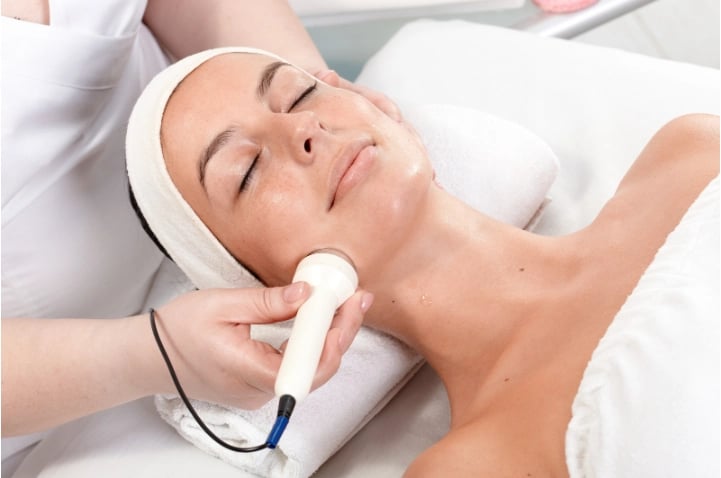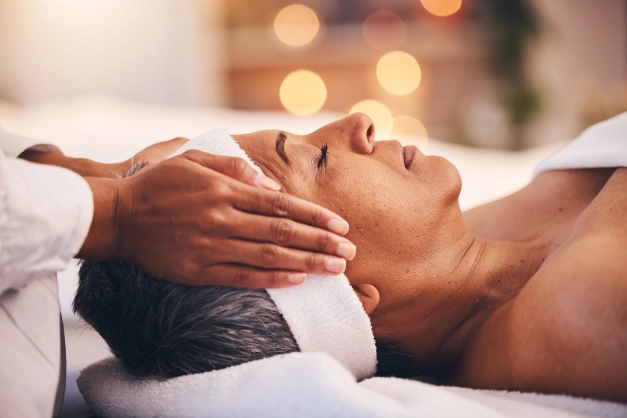A facial can serve many purposes. While some seek out a facial service to simply feel relaxed and pampered, others book a facial to target a specific skincare concern and achieve results.
Depending on your goal, you will choose between a spa facial or a medical grade facial. While they sound similar, they are actually very different!
So, what are those differences? And which type of facial is right for you?
At DLK on Avenue, we offer a range of medical grade facials for all skin types. Our facial treatments help with clarifying and brightening the skin while also promoting anti-aging. We believe that medical grade facials create the best results but understand that this approach isn’t for everyone.
This article will guide you in understanding the true difference between a spa facial and a medical grade facial based on our expertise.
What is a Spa Facial?
A spa facial is a type of skincare treatment that is typically administered by an aesthetician. It uses botanicals, exfoliants, and oils or lotions to exfoliate dead skin cells and remove impurities from the epidermis, the outer layer of the skin.
The goal is to cleanse the surface of the skin, and to promote relaxation, the treatment is often followed by an upper body massage.
The procedure is not customized to specific skin types or concerns and the results are not long-lasting as the primary goal is to soothe and relax the skin, not provide clinical treatment.

What is a Medical Grade Facial?
A medical grade facial, in contrast to a spa facial, is a skincare treatment that is administered by a dermatologist or a medical aesthetician who has been trained by a dermatologist to have a deeper understanding of the skin.
The treatment begins with a detailed analysis of the skin and the client's specific skincare concerns, followed by a personalized treatment plan. Medical grade skincare products, formulated by dermatologists, are used to provide an effective treatment that produces visible and long-lasting results.
Medical grade facials can be used to treat a variety of skincare concerns such as aging, acne scarring, rosacea, melasma, or sun damage and can address multiple concerns at once.
Some common examples of medical grade facials include HydraFacial, Chemical Peels, Medical Microdermabrasion, IPL Photo Facial, Fractora, and MicroNeedling.

What Sets Medical Grade Facials Apart?
Personalized Treatment
Spa facials are not tailored to individual skin types or concerns, while medical grade facials are highly personalized, with a thorough assessment of the skin and a customized treatment plan.
The dermatologist or medical aesthetician will not only recommend the appropriate type of medical grade facial, but also use specific medical grade products that are tailored to the client's skin type and concern.
Medical Grade Skincare Products
Another major difference between spa facials and medical grade facials is the type of products used.
Spa facials use regular skincare products that primarily cleanse, exfoliate, and moisturize the outer layer of the skin, and often contain fragrances and oils that can irritate the skin.
On the other hand, medical grade facials use products that are approved by dermatologists and backed by science, which contain high concentrations of active ingredients that effectively target specific skin concerns and produce real results. These products are formulated to promote optimal absorption, penetrating beyond just the surface of the skin.
Treats Skin Beyond the Surface
Medical grade facials use professional techniques and medical-grade skincare products to address skin concerns at a deeper level. These procedures target the skin at a cellular level, not just the surface. They not only cleanse the skin but also stimulate collagen production, improve blood circulation, deeply exfoliate, remove damaging toxins, and correct skin imperfections.
Long-Lasting Results
Medical grade facials, due to the combination of personalized treatment, the use of medical grade skincare, and targeting the skin beyond the surface, produce long-lasting results.
While a spa facial may provide temporary hydration and radiance, a medical grade facial has the potential to permanently improve skin conditions such as acne, rosacea, or sun damage.
Cleanliness & Safety
Lastly, medical grade facials are performed in medical aesthetics clinics, which are medical facilities operated by medical professionals and have strict protocols in place for cleanliness and safety.
This means that clients can feel confident that their skin condition is being treated in a safe and hygienic environment, free from bacteria or germs.

Get a Medical Grade Facial at DLK on Avenue!
At DLK, we offer a range of medical grade facials for all skin types and concerns.
Our favourite facial is the DLK Power Program. This super facial gives you the exfoliation benefits of microdermabrasion combined with deep facial rejuvenation, plus the infusion of revitalizing ingredients and healing skin oxidization.
This facial will leave your skin feeling plump, hydrated, and youthful!
We also recommend Microdermabrasion or the SilkPeel facial. These treatments are a great way to exfoliate your skin and promote cellular turnover.
Most facial treatments at DLK can be done every 2 to 4 weeks, and for the best results, we suggest a series of 6 treatments.
According to Sarah Oh, a medical aesthetician at DLK, every treatment plan is based on the patient’s unique skin concerns. “Some patients may require a more aggressive approach, in which case laser therapy or epidermal peels may be more suitable. However, with these treatments, patients must be able to commit to a series of treatments and the related downtime.”
Ultimately, the best way to determine which facial is right for you is by booking a consultation with one of our experts.





